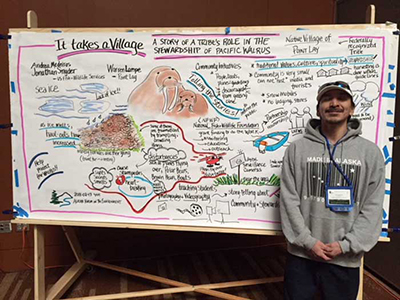The elders in Point Lay, a small Inupiaq village in the northwest reaches of Alaska, remember a time when the Arctic sea ice and the animals that depend on it followed reliable patterns. In particular, they tell of a time when only a handful of Pacific walruses visited the shores of the barrier island just beyond their community.
In recent years, what was once true is no longer. Thousands of Pacific walruses now show up, raising concerns and sparking a community-wide effort to help the massive marine mammal survive in a dramatically changing environment.
“When the walrus first started coming to shore, it was kind of strange to us,” said Leo Ferreira III, a former village tribal president. “Then we just realized that there is no ice and that is why they’re coming to shore.”
The arrival of these big visitors has prompted a partnership that includes the U.S. Fish and Wildlife Service (Service) — an effort designed to protect the seagoing mammals and their young while on shore.
 Since 2007, say biologists, walrus females and their calves have been leaving the Chukchi Sea and coming ashore on a barrier island near Point Lay, a village 700 miles northwest of Anchorage on Alaska’s North Slope. They show up in late summer or early fall — a response, scientists say, to the loss of sea ice. Biologists call these groups of walruses on land haulouts.
Since 2007, say biologists, walrus females and their calves have been leaving the Chukchi Sea and coming ashore on a barrier island near Point Lay, a village 700 miles northwest of Anchorage on Alaska’s North Slope. They show up in late summer or early fall — a response, scientists say, to the loss of sea ice. Biologists call these groups of walruses on land haulouts.
This is a marked change in behavior. Traditionally, mothers and their young left the Chukchi’s depths to rest on sea ice. Walruses are better suited to life on the ice instead of land, as they can slip easily back into the sea to forage or avoid predators.
On land, the creatures are skittish: A sight, sound or odor can cause the walruses to panic and flee to the sea for safety. When large numbers of animals do this it is called a stampede. The animals — particularly the yearlings and calves — can get injured or killed.
Thousands of walruses now come to the barrier island just north of Point Lay, said Jim MacCracken, a supervisory wildlife biologist with the Service. “...The site has been occupied by as many as 40,000 animals at its peak,” he said.
Walruses aren’t the only seasonal visitors to Point Lay. The large mammals’ arrival draws reporters and other curious people, too. That’s not surprising. The creatures are immense — a male walrus weighs about the same as a Toyota RAV-4, about 3,700 pounds.
But Point Lay does not have the infrastructure to host the two-legged visitors: there are no restaurants, and the only lodging in town closed in 2016.
These new challenges prompted a conservation partnership between the Service and the Native Village of Point Lay, the Alaska Native tribe in Point Lay. With support from the National Fish and Wildlife Foundation (NFWF), the tribe and Service monitor and safeguard the haulout. Those efforts include notifying people that the animals are on shore and providing guidelines for those who travel in the area, including pilots, mariners and subsistence hunters.
Aircraft overflights are particularly concerning.“We noticed that during that time the airplane traffic was causing stampedes,” said Ferreira. “I witnessed it with my own eyes.”
The Service and village contact local air carriers directly and work with the Federal Aviation Administration to let pilots know when the animals have hauled out and provide the guidelines.
The partnership doesn’t end there. The Service and the tribe have worked with the nonprofit Alaska Teen Media Institute to develop short educational videos about the community, its traditions and its connection to the walrus. Youth at the local school, with training and support of the institute, interviewed elders and one another for the videos.
Point Lay and the Service have a common goal: to keep walruses around for future generations.
In Point Lay, people are guided by their traditional value of respecting the earth and all that it provides for future generations. The Service and the tribe will continue to work together to keep the walruses safe while on shore.
“We can prevent walrus disturbance and many trampling deaths,” Ferreira said, “but everyone needs to listen and pay attention to help the walrus.”
 Sign In
Sign In
 Sign In
Sign In
